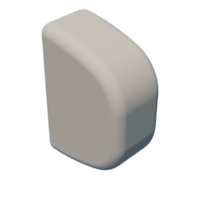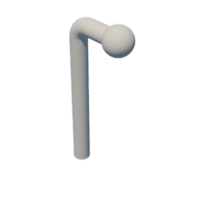Introduction: Elaboration of Lateral Trunk Supports for a Wheelchair User With Scolosis
According to Convention on the Rights of Persons with Disabilities, Disability is an evolving concept resulting from the interaction between people with impairments and barriers due to attitude and environment that prevent their full and effective participation in society [1]. According with the World Health Organization, it is estimated that 1.3 billion people, or 1 in 6 people worldwide, suffer from a disability, and from this number, 70 million people need a wheelchair [2].
Due to the various difficulties present in the social context, there are a small number of people who use wheelchairs and have the possibility of accessing technology that adapts to their injury, functionality, and ability to perform productive activities [3] for this reason, users who use wheelchairs for long periods (more than 8 hours per day) and do not have appropriate wheelchair for their particular conditions like scoliosis often experience significant levels of discomfort, this has a negative impact on the user, causing pain, discomfort, risk of injury, posture problems, decreased movement, etc., which directly affects their quality of life. To improve this problem, a few specialists have developed improvements with wheelchair aimed at seat customization. [4]
The user we will be working with has a condition that affects her spine, called spina bifida, so she uses a wheelchair; in addition to this, she also has scoliosis. Unfortunately, the wheelchair she uses is not suitable for her condition, so it has caused her problems, one of the most notorious affectations is the worsening of her scoliosis. According to Mayo Clinic, scoliosis can lead to complications like respiratory problems, back problems, or appearance problems. [5]
Neuromuscular Scoliosis is a spinal curvature that occurs in children with cerebral palsy, muscular dystrophy, and spina bifida. These types of disorders can prevent the spine from being supported by the muscles and lead to scoliosis and other abnormal curvatures of the spine [6]. There are some main symptoms of scoliosis that include: tilted, uneven shoulders and shoulder blades, the ribs on one side stick out, uneven waistline, one hip higher than the other and back pain. However, in children who also require wheelchairs, spinal curves may cause other changes like tilted pelvis, difficulty in sitting and the need to use the hands and arms for support while seated, pressure sores due to the pelvic and overall imbalance, a change in one´s overall posture, such as slouching or leaning more to one side. Also, this condition may also develop other types of spinal curves, decrease the space in chest for the lungs and lead to breathing problems.
Therefore, the Southwest Scoliosis and Spine Institute proposes various solutions for this situation, which largely depend on the type and severity of the spinal curve and the nature of any other conditions, as well as the patient’s age and the stage of the curve. We will focus solely on those that do not require surgical intervention.
Wheelchair modification: This method stands as the primary non-surgical approach for addressing neuromuscular scoliosis. When the patient's pelvic alignment affects their balance, modifying the wheelchair to enhance posture can yield significant benefits. This can involve customizing the wheelchair with tailored back supports and fine-tuning side positioners to promote stability during seated activities.
Scoliosis brace: In cases where wheelchair use is necessary, healthcare providers may suggest the application of a custom-molded plastic brace. These braces wrap around the upper body, providing stabilization while allowing the individual to retain the use of their arms and hands. However, it's important to note that for individuals capable of walking, bracing may not be advisable as it could increase the risk of falls, particularly among those with muscle weakness or an unsteady gait.
According to various sources, a modification that has had a significant impact in recent years and has been beneficial is the ability to tilt, offering pressure relief, improved blood circulation, digestive aid, easier and more efficient breathing, improved vision and interaction, safety and ease of transfers, and prevention of musculoskeletal complications. [7]
An important accessory is the lateral support, designed to provide additional postural support for patients who need to maintain their balance and stability while seated in a wheelchair. This type of support is useful for people with paraplegia or quadriplegia, those who have suffered brain or spinal cord injuries, and also for patients with conditions such as scoliosis, amyotrophic lateral sclerosis (ALS), multiple sclerosis (MS), muscular dystrophy or cerebral palsy. [8]
Although there are several types and styles of lateral supports on the market, only a few provide secure support for the patient, while allowing him or her to flex and move laterally.
The objective of this project is to develop customized lateral trunk supports that provide the user with adequate support and alignment of the spine while seated in their wheelchair. These supports should be adapted to the specific needs of the user, taking into account his or her scoliosis condition and any other relevant individual considerations.
special thanks to our user for agreeing to be part of this project.
References
1. United Nations (2008). Convention on the Rights of Persons with Disabilities – Articles | United Nations Enable. Un.org, 2022. https://www.un.org/development/desa/disabilities/convention-on-the-rights-of-persons-with-disabilities/convention-on-the-rights-of-persons-with-disabilities-2.html
2. World Health Organization (2022). Discapacidad. Ginebra, Suiza. https://www.who.int/es/news-room/fact-sheets/detail/disability-and-health
3. Velásquez, J. (2016). Eficacia de asientos conformados en usuarios de sillas de ruedas con el uso de una espuma de poliuretano tipo foam in place. Universidad CES Facultad de fisioterapia. Recuperado de: https://repository.ces.edu.co/bitstream/handle/10946/2748/Eficacia_Asientos_Sillas_Rueda.pdf?sequence=1&isAllowed=y
4. Crane, Barbara A. PhD, PT, ATP; Holm, Margo B. PhD, OTR/L; Hobson, Douglas PhD; Cooper, Rory A. PhD; Reed, Matthew P. PhD. A Dynamic Seating Intervention for Wheelchair Seating Discomfort. American Journal of Physical Medicine & Rehabilitation 86(12):p 988-993, December 2007. | DOI: 10.1097/PHM.0b013e3181583ed9
5. Mayo Clinic. (2023) Escoliosis - Síntomas y causas . Mayoclinic.org https://www.mayoclinic.org/es/diseases-conditions/scoliosis/symptoms-causes/syc-20350716
6. The Southwest Scoliosis and Spine Institute (2022). Neuromuscular Scoliosis. https://scoliosisinstitute.com/neuromuscular-scoliosis/
7.Umar Maniar (2023). The best tilt wheelchairs for scoliosis. Future Mobility Healthcare. https://www.futuremobility.ca/best-tilt-wheelchairs-for-scoliosis-guide/
8. Dias, Madara Nilakshie. Development of a dynamic wheelchair lateral support. Retrieved from https://doi.org/doi:10.7282/t3-77hd-zv37
Step 1: Patient Evaluation
The user of this project is a wheelchair user who has scoliosis. It is important to recognize that each individual with scoliosis may have varying degrees of severity in their condition, as well as specific needs in terms of support and comfort when using a wheelchair.
User Profile
· Age: 24 years old
· Gender: Female
· Medical Diagnosis: Congenital Type 1 scoliosis An S-shaped curve crossing the midline of the thoracic and lumbar curves. The lumbar curve is larger and more rigid than the thoracic curve (the types of scoliosis are shown in the picture). In the fisrt curve, she has moderate scoliosis in the thoracic area according to x-rays 27°, but because of the progression of the scoliosis, the current scoliosis is estimated to be moderate to severe. The user has not previously received treatment for scoliosis. Second curve is located in the lumbar region, according to x-rays taken at 10 years of age, the angle of severity is 38°, however, as scoliosis is a progressive condition, we currently find an angle of severity close to 55° that is >40°, which would place the user in a severe scoliosis (Image 1).
· Mobility Level: The user is dependent on a wheelchair for mobility, which implies specific considerations in terms of accessibility and safety. This project will work with the TROTTER model TR-1200 wheelchair (Image 2).
· Specific Needs: May include requirements for lateral support due to scoliosis, as well as other needs related to comfort and functionality of the wheelchair.
· Activities and Lifestyle: Performs activities of daily living that require him/her to be in the wheelchair most of the day.
Step 2: Measurement
· Information about the wheelchair and the model can be found on the Trotter website, it is important for develop a suitable lateral support.
· Measurements of the user were taken manually by placing the user lying down in the first part and sitting in the second part.
Step 3: Design
The design consists of 4 pieces, a clamp, the head, the insert and cushion, basically the clamp is a link with 3 holes of 5 mm in diameter, which is screwed into the frame of the wheelchair, being a clamp allows you to have different heights, On the other hand, the head and the insert have a joint as is the femur to the hip, this allows it to rotate on its own axis, giving the possibility of an ergonomic fit of the cushion to the user's desire, the head is screwed and tightened from the clamp.
Step 4: Materials Needed:
Materials Needed:
· X-rays or images of the patient's spine (optional)
· Photographs of the patient's wheelchair
· Wheelchair model Trotter TR 1200
· Padded fabric
· Sewing tools (sewing machine or needle and thread)
· Tube with a diameter of 22mm preferably protected against corrosion.
· Nylamid
· Screws (M3X60)
· Tube supports (flange)
Materials are show in the image
Step 5: Nylamid: Connection Block Cutting
From the measurements of the wheelchair tube, two pieces were obtained that will function as a base for the cushion and will generate the connection between the chair and the support.
Both pieces were cut using a bench drill
Step 6: Nylamid: Pad Block Cutting
Two Nylamid blocks were cut to be used as a support inside the pad
Step 7: Join Flange, Tube and Nylamid Block for the Pad
We taked the nylamid and drill three corresponding holes to be able to join it with the flange, as shown in image 1.
Subsequently, we join the flange to the pipe using a rivet, as shown in picture 2.
Finally, using screws, we joined the flange to the nylamid as shown in picture 3.
Step 8: The Construction of the Pad
For the pad, we used fabric for the pad filling. With the fabric we covered the nylamid bar for not to hurt our user, and making comfortable supports. Also, we covered the plate and the filling with a blue waterproof fabric.
In the Images you can observe the result
Step 9: Assembly Heights
To establish the heights of the supports, taking into account the measurements of our user, we made two elbows to connect the tubes and generate the corresponding angle to reach the desired height. One of the elbows is shown in Image 1.
One elbow was placed at 17 cm (Image 2) and the second at 10 cm (Image 3).
Step 10: First Assembly
Assemble the parts resulting from the above steps and obtain the final assembly, do not forget to tighten the screws.
Step 11: Final Assembly
Finally, place the pads on the flanges and secure them with the screws, the result can be seen in the attached images.
Step 12: User Postural Test
To evaluate the user's implementation of lateral supports, we used APECS, an application that uses photogrammetric algorithms to provide accurate posture assessments.
The frontal plane reference points taken into account are:
- Lobulus Auriculae (Left and right)
- Acromion (Left and right)
- Jugular Notch
- Iliospinale Anterius - Anterior Superior Iliac Spine (Left and right)
- Anterior Tibial Tuberosity (Left and right)
- Midpoint Between Malleoli (Left and right)
In the image A you can see the user's posture without the side supports and in tne image B you can see the user's posture with the side supports. It can be observed that the posture improved when using the supports since we observed a decrease in the angle marked by the Liospinale Anterius, from 19º to 16°













![Tim's Mechanical Spider Leg [LU9685-20CU]](https://content.instructables.com/FFB/5R4I/LVKZ6G6R/FFB5R4ILVKZ6G6R.png?auto=webp&crop=1.2%3A1&frame=1&width=306)



